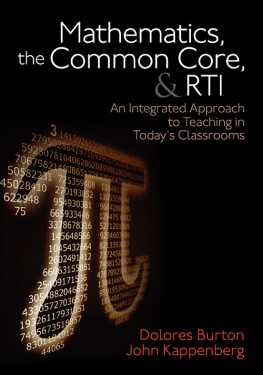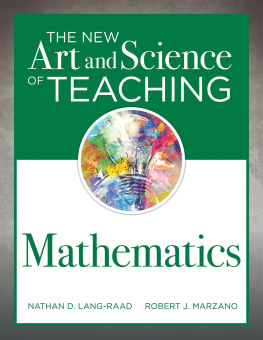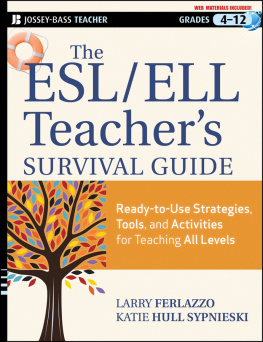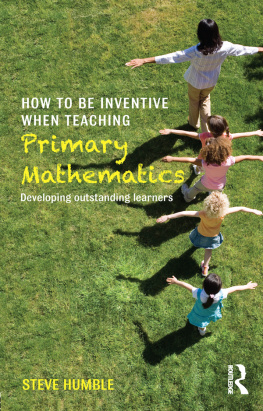Succeeding
at
Teaching
SECONDARY
Mathematics
The authors wish to dedicate this book
to their children, Alan, Jack, Katie, and Sandra.
Succeeding
at
Teaching
SECONDARY
Mathematics
Your First Year
Cheryl D. Roddick // Julie Sliva Spitzer

Copyright 2010 by Corwin
All rights reserved. When forms and sample documents are included, their use is authorized only by educators, local school sites, and/or noncommercial or nonprofit entities that have purchased the book. Except for that usage, no part of this book may be reproduced or utilized in any form or by any means, electronic or mechanical, including photocopying, recording, or by any information storage and retrieval system, without permission in writing from the publisher.
For information:
 | Corwin
A SAGE Company
2455 Teller Road
Thousand Oaks, California 91320
(800) 233-9936
Fax: (800) 417-2466
www.corwin.com | SAGE India Pvt. Ltd.
B 1/I 1 Mohan Cooperative Industrial Area
Mathura Road, New Delhi 110 044
India |
SAGE Ltd.
1 Olivers Yard
55 City Road
London EC1Y 1SP
United Kingdom | SAGE Asia-Pacific Pte. Ltd.
33 Pekin Street #02-01
Far East Square
Singapore 048763 |
Printed in the United States of America
Library of Congress Cataloging-in-Publication Data
Succeeding at teaching secondary mathematics: your first year/Cheryl D. Roddick and Julie Sliva Spitzer.
p. cm.
Includes bibliographical references and index. ISBN 978-1-4129-2763-5 (pbk.)
1. MathematicsStudy and teaching (Secondary) I. Roddick, Cheryl D. II. Spitzer, Julie Sliva.
QA11.2.S87 2010
510.712dc22 2009045333
This book is printed on acid-free paper.
10 11 12 13 14 10 9 8 7 6 5 4 3 2 1
| Acquisitions Editor: | David Chao |
| Editorial Assistant: | Sarah Bartlett |
| Production Editor: | Cassandra Margaret Seibel |
| Copy Editor: | Cate Huisman |
| Typesetter: | C&M Digitals (P) Ltd. |
| Proofreader: | Susan Schon |
| Indexer: | Gloria Tierney |
| Cover Designer: | Karine Hovsepian |
Contents
Acknowledgments
C orwin gratefully acknowledges the contributions of the following individuals:
Mary Kollmeyer, Mathematics Teacher
Lejeune High School
Camp Lejeune, NC
Amanda McKee, Mathematics Instructor
Johnsonville High School/Florence County #5
Johnsonville, SC
Melissa Miller, Middle Level Educator
Lynch Middle School
Farmington, AR
Gerald R. Rising, Distinguished Professor Emeritus
University at Buffalo, State University of New York
Buffalo, NY
Judith A. Rogers, K5 Mathematics Specialist
Tucson Unified School District
Tucson, AZ
About the Authors
 Cheryl D. Roddick is an associate professor in the Department of Mathematics at San Jos State University. She currently teaches mathematics and mathematics methods courses to preservice teachers in elementary and secondary education. She also supervises field experiences for student teachers at the secondary level.
Cheryl D. Roddick is an associate professor in the Department of Mathematics at San Jos State University. She currently teaches mathematics and mathematics methods courses to preservice teachers in elementary and secondary education. She also supervises field experiences for student teachers at the secondary level.
Dr. Roddicks research interests include the conceptual understanding of fractions and how teachers thoughts evolve relative to teaching mathematics. She has presented her research in local as well as national mathematics education conferences. She also facilitates K12 inservice activities with teachers in local school districts. Dr. Roddick may be reached at .
 Julie Sliva Spitzer brings to this topic a rich background in mathematics, technology, and special education. As an associate professor of mathematics education at San Jos State University, she teaches methods of mathematics instruction to aspiring educators and supervises their field experiences. Dr. Spitzer continues to enjoy inservice work with teachers Grades K12.
Julie Sliva Spitzer brings to this topic a rich background in mathematics, technology, and special education. As an associate professor of mathematics education at San Jos State University, she teaches methods of mathematics instruction to aspiring educators and supervises their field experiences. Dr. Spitzer continues to enjoy inservice work with teachers Grades K12.
Her research interests include studying teacher and student attitudes toward teaching and learning mathematics, and best practices for teaching mathematics to special needs learners. She is a frequent presenter at annual meetings of the National Council of Teachers of Mathematics and at other local conferences. Dr. Spitzer can be reached at .
Introduction
T hroughout our collective years as mathematics educators, we have found that new teachers are concerned about many of the same issues surrounding mathematics education. We realized that there is a critical need to ease the transition to teaching mathematics, and it goes beyond the teacher preparation programs that new teachers have completed. Our goal with this book is to supplement what new teachers of mathematics have already learned about teaching mathematics and to focus on the key elements of successful teaching.
In this book we have used a combination of research, personal experiences, and observations of other mathematics teachers. We present all the ideas that we have found to be extremely important to the developing teacher of mathematics. We have included many of the common problems and big ideas in mathematics in many vignettes sprinkled throughout the book. The vignettes were inspired by real teachers in real classrooms, and we hope they encourage thought-provoking discussion on important issues in content as well as pedagogy in mathematics lessons for Grades 612.
We would like you to keep in mind as you read this book that there is no one right way to approach teaching and that you are already in the process of developing your own philosophy of teaching and learning. This book is meant to be used as a tool to help you think about the important issues that can shape the kind of teacher you are meant to be. We hope that by reading this book you will get a better understanding of the strong connections inherent in mathematics as a body of knowledge and begin to see how everything you teach can be connected to other concepts or understanding.
HOW THE BOOK IS ORGANIZED
: A Glimpse at Mathematics Instruction. This chapter provides a look at mathematics instruction in two classrooms. With two vignettes we set the stage for the rest of the book by introducing elements of successful mathematics instruction.
by discussing standards-based teaching in mathematics. We look at the standards set forth by the National Council of Teachers of Mathematics, as well as discuss the importance of standards created at the state and district levels. We also provide examples of standards-based teaching relative to algebraic reasoning.
: Engaging Students in Learning Mathematics. In this chapter we take a look at the three interrelated components of engagement: the affective, behavioral, and cognitive. We begin with the affective component in light of Glassers categorization of a human beings five basic needs: (1) survival, (2) love and belonging, (3) fun, (4) freedom, and (5) power. We describe how each of these basic needs is reflected in the classroom and how you can use knowledge of these basic needs to create an inclusive classroom environment.











 Cheryl D. Roddick is an associate professor in the Department of Mathematics at San Jos State University. She currently teaches mathematics and mathematics methods courses to preservice teachers in elementary and secondary education. She also supervises field experiences for student teachers at the secondary level.
Cheryl D. Roddick is an associate professor in the Department of Mathematics at San Jos State University. She currently teaches mathematics and mathematics methods courses to preservice teachers in elementary and secondary education. She also supervises field experiences for student teachers at the secondary level. Julie Sliva Spitzer brings to this topic a rich background in mathematics, technology, and special education. As an associate professor of mathematics education at San Jos State University, she teaches methods of mathematics instruction to aspiring educators and supervises their field experiences. Dr. Spitzer continues to enjoy inservice work with teachers Grades K12.
Julie Sliva Spitzer brings to this topic a rich background in mathematics, technology, and special education. As an associate professor of mathematics education at San Jos State University, she teaches methods of mathematics instruction to aspiring educators and supervises their field experiences. Dr. Spitzer continues to enjoy inservice work with teachers Grades K12.